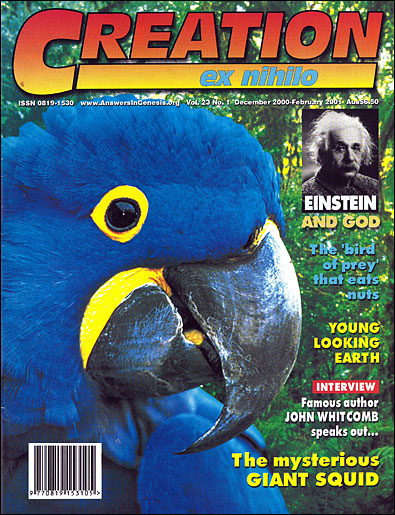The ‘bird of prey’ that’s not

Images of vultures circling ominously overhead are often used by Hollywood to signal the imminent demise of someone lost or dying out in the wilderness. So, many people would know vultures to be carrion-eaters, picking the flesh off carcasses of animals that succumbed to the scorching midday sun or were killed by predators.
But one species of vulture is very different. Known as the ‘palm nut vulture’, it feeds almost exclusively on the fleshy outer portions (husk) of the fruit of the oil palm (Elaeis guineensis), or, less frequently, Raphia palm (Raphia spp.).1 It lives almost entirely in those areas of Africa where the oil palm occurs—forests, savannahs, and mangrove swamps.2
The very idea of a ‘vegetarian vulture’ using its sharp beak to tear/cut the husks of nuts (rather than to tear meat) would probably surprise most people.3 However, the palm nut vulture is apparently well-known across many nations of central, western and southern Africa, featuring on postage stamps of Tanzania, Gabon, Angola, Gambia and Ghana.4 The palm nut vulture even figures as the faunal emblem on the coat-of-arms of the Mtunzini Town Board, in South Africa.5 It has been seen living at elevations of up to 1,800 metres (6,000 feet) in Kenya, but is more frequently found in lower areas. It is a fairly sedentary species, often spending all its life within quite a short range of the breeding site. Nests one metre (3.5 feet) across and 40–50cm (1.5 feet) deep have been observed in large trees, up to 60 metres (200 feet) above the ground.1
Feeding from sunrise and also in the late evening, the palm nut vulture will visit the same palm, day after day, for as long as the fruit lasts. (Interestingly, the palm nut vulture often has to compete with a bird-of-prey ‘cousin’, the African Harrier Hawk (Polyboraedes typus), which also seeks out oil palm fruit when available, though it does not depend on it.6) So what does the palm nut vulture eat when oil palm nuts or Raphia fruit have run out? Crabs, molluscs, etc., picked up on the seashore; occasionally fish snatched from the water’s surface. Giant snails and locusts are also taken occasionally. But for the palm nut vulture, oil palm husk is such a favoured food, that when it is available, all meat options are rejected.1
The palm nut vulture’s distinct preference for oil palm and Raphia fruit, only turning to crabs, molluscs, etc., when its favoured vegetarian fare is unavailable, perhaps helps us understand how many animal and bird species first turned to carnivory after the Fall. Originally, of course, animals and birds were vegetarian (Genesis 1:30). However, in a post-Edenic fallen world of sin and death—a ‘groaning’ creation in ‘bondage to decay’ (Romans 8:20–22)—it may have been the first seasonal food shortages that drove starving animals and birds to eat other creatures when their preferred plant food was unavailable. Ecologists today are finding that, in the wild, many animal species commonly thought of as being solely carnivorous may in fact supplement (or even, at times, replace) their meat diet with vegetable matter (see, e.g. Piranha, Creation 22(4):20–23). And many pet owners speak of the capacity of meat-eating animals to live on vegetarian diets (see The lion that wouldn’t eat meat, Creation 22(2):22–23).7 Perhaps such observed behaviour is a legacy of a time when animals and birds gorged themselves peaceably on ‘every green plant’, i.e. prior to the tragic entry of death and suffering into the world because of man’s sin (Genesis 3; Romans 5:12).
References and notes
- Palm Nut Vulture—Gypohierax angolensis, www.hawk-conservancy.org/priors/palmvulture.htm, September 12, 2000. Return to text.
- Apparently the palm nut vulture can only live in areas where either oil palms or Raphia palms are present. Ref. 1. Return to text.
- Unlike most carrion-eating vultures, which usually are bare on the head and neck except for a thin covering of down (probably a distinct asset when extracting meat from a rotting carcass), the palm nut vulture is unfeathered only in the area around the eyes, and a streak running aft from the base of the bill. Ref 1., and Vulture Biology, www.accutek.com/vulture/biology.htm, September 12, 2000. Return to text.
- Palm Nut Vulture stamps, www.bird-stamps.org/species/30043.htm, September 12, 2000. Return to text.
- The Raphia palms at Mtunzini, South Africa, www.pacsoa.org.au/palms/Raphia/australis.html, September 12, 2000. Return to text.
- African Harrier Hawk or Gymnogene—Polyboraedes typus, www.hawk-conservancy.org/priors/jimmy.htm, September 12, 2000. Return to text.
- Since publishing that ‘vegetarian lion’ article, we have heard that during World War II, when meat was expensive and in short supply, zookeepers successfully kept lions and other carnivorous species alive by supplementing their diet with vegetables. Return to text.





Readers’ comments
Comments are automatically closed 14 days after publication.